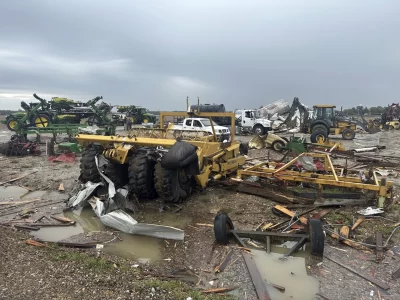
An emergency management official in a county hit hard by a tornado outbreak in Iowa last weekend said delayed tornado warnings did not hinder local response times. Nevertheless, the National Weather Service (NWS) is currently implementing procedural changes to avoid a repeat of the delays that communication platforms experienced amid a deadly outbreak of severe weather and tornadoes last weekend, according to an NWS spokesperson.
The communication delays lasted between two to seven minutes, primarily impacting weather.gov and Wireless Emergency Alerts from 2 p.m. until 6 p.m. CST Saturday during the height of the storms.
Daryl Herzmann, a system analyst for the Iowa Environmental Mesonet, a branch of Iowa State University that archives weather data, told AccuWeather that on Saturday he had been watching issuances through the various data systems that he helps operate when he noticed something was off.
“There was one point in time where there was no tornado warning showing up on my display and I thought that was puzzling because I knew that there was a tornado on the ground at the time,” Herzmann said.
He logged into the NWS chat, where he saw the weather service was alerting members of the media and emergency management that they were noticing a dissemination delay with their products.
“I then started double-checking some things on my end,” Herzmann said. “I have some diagnostics on data flow, so I was able to see that sure enough there was a latency.”
The technological issue stemmed from one of the communications pathways experiencing a brief message backlog. This was traced to a network hub in Dallas-Fort Worth, where forecasters were using a satellite backup rather than their primary land-based connection since the latter was offline due to a damaged fiber optic cable, NWS director of public affairs Susan Buchanan told AccuWeather via email. She added that even with the technical difficulties, tornado warnings were issued and communicated to the public in advance of every tornado that touched down in Iowa on March 5.
“Our systems engineers quickly took action to identify and resolve the issue causing the communications delay as soon as it was detected,” Buchanan said.
Buchanan listed a few factors that combined to contribute to the messages backing up: the Dallas-Fort Worth is not only a network hub but also a multi-unit facility that combines the forecast office and river forecast center, resulting in higher message output. However, since the fiber landline the office would normally use had the damaged fiber optic cable, the office instead had to switch to using a satellite backup connection, which has comparatively less throughput, or the ability to send data over a given amount of time.
Factor in the increase of messages within the hub cluster due to the severe weather and you’ve got an increase in messages outpacing the satellite connection’s ability to relay them. It created a “choke point” for the outgoing products, as Herzmann explained.
Once the hub was taken out of the network, “warnings began flowing with no delay,” Buchanan said, adding that the office was kept offline until its primary network was repaired.






